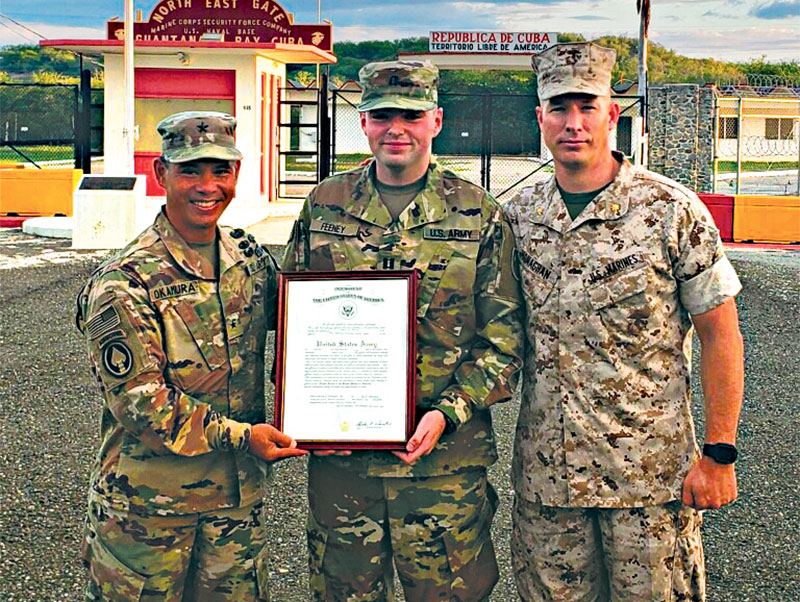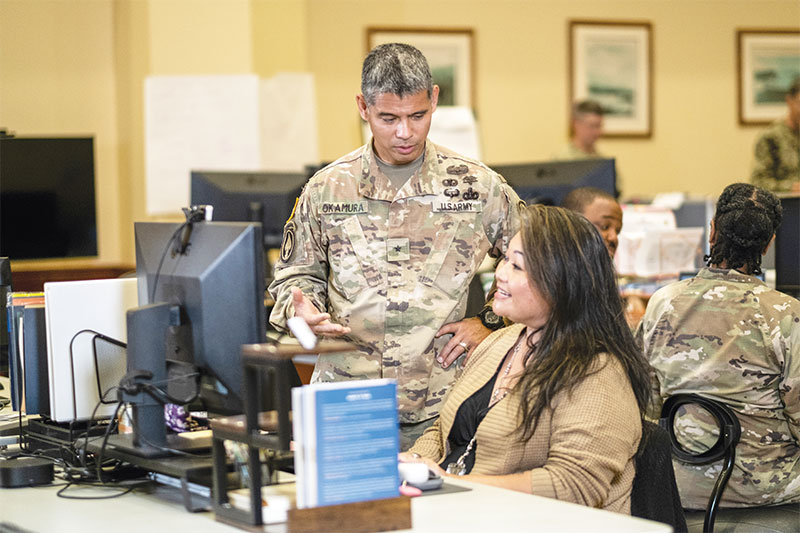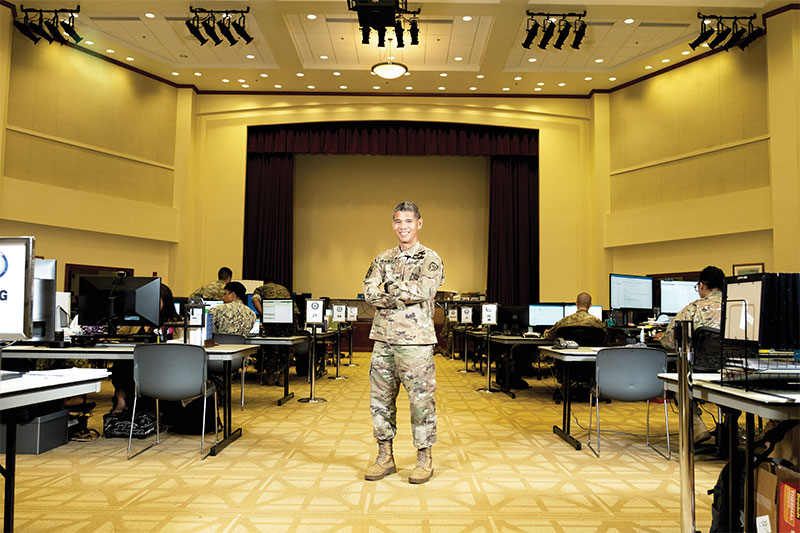Man On A Mission
Lance Okamura has dedicated his life to completing assignments in the service of others. His latest task? Rebuild trust with the public in the wake of the Red Hill disaster.
Communication breakdowns happen everywhere in life, even in the usually orderly world of the military.
Brig. Gen. Lance Okamura knows this first-hand. On the morning of Oct. 1, 2022, he awoke at Guantanamo Bay to a barrage of personal emails congratulating him on his upcoming trip home to Hawai‘i, where he was to be installed as director of strategic engagement of Joint Task Force-Red Hill. Problem was, no one from the military had even bothered to give him the news — this despite U.S. Defense Secretary Lloyd Austin’s announcement 24 hours earlier at a press conference.
“Normally when you get your assignment, there’s an actual person who calls and prepares you,” explains Okamura. “But there was no preparation whatsoever.”
Even the human resources agency for the U.S. Army’s general officer corps was unaware of the new assignment. Okamura immediately forwarded a copy of the press release to the department and requested confirmation.

Okamura, at left, then-commander of Joint Task Force-Guantanamo, presents Lt. Justin Feeney with a plaque signifying his promotion to the rank of captain. At right is Maj. Michael Monaghan, the commanding officer of Marine Security Forces — the unit responsible for protecting Naval Station Guantanamo Bay from external threats. PHOTO COURTESY LANCE OKAMURA
“I asked, ‘Is this really going to happen?’ They said, ‘Hmm … well, yeah. If the secretary of defense said it, then we’ll have to make it happen,’” recalls Okamura, chuckling at the memory of the conversation.
“So literally in a matter of weeks, I was packing up my stuff and coming here.”
Now several months into his latest assignment, a mission that requires navigating through what he calls “the complexities of Red Hill” — specifically, the safe removal of 104 million gallons of fuel while staying on course to hit the facility’s targeted defueling completion date of June 2024 — Okamura remains pleased to be back in familiar terrain, a son of the ‘āina who stands at the ready to “serve my community … serve the people of Hawai‘i.”

Okamura discusses strategic engagement opportunities with Rana Lynn Kennedy, chief of legislative affairs, at Joint Task Force-Red Hill headquarters on Ford Island. ANTHONY CONSILLIO PHOTO
Interestingly enough, his chief responsibility with JTF-Red Hill is to ensure open lines of communication as he attempts to rebuild trust with the public.
“I’m required to engage with members of the community, from the local and state level all the way up to the federal and congressional level, to ensure that they understand that we are doing the right thing for the right reason, that we’re being open, communicative and transparent, that we’re consistent in our messaging, and most importantly, that we’re fully committed to protecting the environment and the people of Hawai‘i,” he says.
True to form, the decorated Okamura welcomes his latest challenge of helping to clean up the environmental disaster at Red Hill — a crisis that began in 2021 when fuel leaked from an underground fuel storage facility into a freshwater aquifer and contaminated sources that provided drinking water to area residents. He points out that of the 253 repairs and modifications identified as problematic at the facility, nearly 70% of them (174) have been completed.
“I can’t say we’re ahead of schedule,” says the man who’s received such honors as the Defense Superior Service medal, the Legion of Merit and the Bronze Star Medal over the course of his distinguished military career, “but we’re definitely on schedule.”
He also hopes to clean up misperceptions surrounding Red Hill in his engagements with the community, including the belief among some that the facility will be reused for fuel in the future.
That’s not happening, reassures Okamura.
“The repair work that we’re doing is so we can safely get rid of the fuel,” he explains, adding there are other established facilities throughout the Pacific that eliminate the need to ever store fuel at Red Hill again.
“We don’t want another fuel leak or fuel spillage, but we have to do these repairs to make sure the integrity of the facility and the pipes are at 100% so that we can successfully defuel.”
While Okamura has complete trust in the team at JTF-Red Hill — “We have brilliant engineers who have already figured out how we are going to safely transfer the fuel,” he says, beaming with pride — he also understands the difficulty of regaining the trust of locals when considering a historical record that demonstrates “years of unfulfilled obligations by the military in mutual environmental stewardship.”
“Growing up, I have memories of Kaho‘olawe, where the island was used for targeting practice and was bombarded repeatedly, which ruined the environment. To this day, Kaho‘olawe is still uninhabitable,” he says.
“In Hawai‘i, people have long memories. They don’t want Red Hill to be another Kaho‘olawe, where this just extends for years … where we don’t care for the environment, don’t take care of the water.”
That’s why it’s important for Okamura to remain in constant dialogue with the public, reassuring all who will listen that headway is being made regarding the facility’s eventual closure and the end result will be pono, the Hawaiian word for “righteous, moral and correct,” for the people.
“Even though the process is slow and it may not be happening as fast as many would desire, we’re still making progress to ensure that Red Hill will in fact be closed, shut down and, more importantly, that the environment will be clean and safe for future generations,” he promises.
Clearly, Okamura is the right man for the job. He is intelligent, highly disciplined and committed to assigned tasks. He’s also extremely service-oriented, productive and successful at what he does. In essence, he shines as a man in uniform and relishes his role in the military.
Still, he hasn’t always felt love for the armed forces. In fact, as the son of a career U.S. Air Force airman, he actually had contempt for the service early on.
The genesis of his disdain began soon after Okamura’s older sister contracted measles encephalitis and suffered brain damage. To assist, the U.S. Air Force promised his father, Neil, that it would no longer move his family from place to place but permanently settle them in Hawai‘i, where all the necessary support services would be available for his disabled daughter. Yet as part of this arrangement, the elder Okamura would be obligated to serve yearlong hardship tours elsewhere in the world, and this order would have to be fulfilled every three years.
Needless to say, the deal left a bitter taste in his young son’s mouth.
“Growing up, I would often ask, ‘Why is my dad gone?’” recalls Okamura. “There was this level of animosity I had toward the military because they were taking my father away. As a result of my father not being there, I saw all the hardships my mother (Viola) had to endure caring for my sister.”
Those feelings were only exacerbated while enrolled at Kamehameha Schools in the ’80s, when Okamura discovered there was mandatory participation in its Junior Reserve Officers’ Training Corps program. Grudgingly, he went along with it, but by the time of graduation, he wanted no part of continued military involvement.
Instead, he chose to pursue business management at Brigham Young University in Provo, Utah. Eventually, he interrupted his studies to serve a two-year mission for The Church of Jesus Christ of Latter-day Saints in Singapore, Malaysia and Indonesia — a period in which he began to mature, find his purpose and focus on things that really mattered.
“That’s when you really learn the values of sacrifice and service. You’re on your own, for all intents and purposes, and there’s no person telling you what to do, what to say,” he explains. “At the same time, you have a goal of providing service to the people that you’re living with. Those two years of serving overseas were like humanitarian service, and I was like, ‘Wow! Now this is something I truly enjoy.’ It brought meaning to my life.”
Following his return from a church mission and a subsequent heart-to-heart with his father about his future, Okamura made up his mind: Serving in the military would suit him just fine.
He chose the U.S. Army — a decision based on his favorable impression of “a poster of a paratrooper jumping out of an airplane … looking really tough and strong” and believing “that’s for me … that’s what I need to do.”
Yet despite entering basic training and airborne school, and later returning to BYU-Provo to, in part, join its ROTC program, his intention was to keep his total time in the military brief. Okamura gave it “four to six years in the U.S. Army” — tops.
But as he found out, best-laid plans often go awry.
“I figured (the military) was just a means to an end,” confesses Okamura, who received his commission in 1995. “Now some 28 years later, I’m still here.”
What convinced Okamura to remain in uniform and serve his country were the terrorist attacks on 9/11. As he explains, “It made me realize that there’s something more important than just me.”
Since then, he’s continued to display selflessness and excel wherever he has been asked to serve. His past strategic-level staff assignments include appointments as National Intelligence Support Team commander and joint operations officer for the chairman’s Joint Chiefs of Staff Director of Intelligence, chief of counter-terrorism programs for Special Operations Command Pacific, deputy director for the Joint Interagency Coordination Group and director for the Office of FBI-Military Affairs Counter-Terrorism at U.S. Pacific Command. Aside from his tours in Afghanistan and Iraq, the former military police officer has also been deployed in support of operations such as Enduring Freedom, Operation Noble Eagle and the Hurricane Floyd Disaster Relief Mission.
After two decades of complete dedication to the U.S. Army, Okamura was finally prepared to retire in 2015. Even when he was offered the rank of general, he initially declined the promotion because he felt it was time to support his wife, Tracy, and her career as an FBI agent.
But after talking things over with her (“She basically told me, ‘You’re an idiot. Take the general offi-cer promotion,” he recalls with a laugh), Okamura reconsidered and accepted the advancement offer. His first task: to lead Joint Task Force-Guantanamo as its commander.
He describes his time at Gitmo, the well-known detention camp located in Cuba, as “challenging, but one that I enjoyed immensely.” Responsible for the safety and general welfare of detainees awaiting trial or being prepared for transfer to another country, Okamura is proud of his track record of providing “humane and legal care to those who were under our care and custody.”
He’s also honest about how he was pegged for this particular assignment:
“One of the reasons why I was selected to be the commanding general down in Joint Task Force-Guantanamo was because while I was in Washington, D.C., I was part of the design team to figure out the future of Guantanamo,” he explains. “It was never my intent to go down there, but as part of the planning team, they made the decision: ‘Hey, Lance, we got a great idea. You were part of the design team — now you get to go and implement the plan.’”
Part of the challenge he faced while serving at Guantanamo Bay Naval Base (and really through much of his military career) was separation from his wife and their two children. Sure, Tracy would catch flights down to Cuba “maybe a couple of times a year,” and Okamura would return for short visits every now and then as well, but mostly there were far too many months of living apart.
The irony is not lost on the brigadier general when recalling his adolescence, and the intense resentment he had for the military for removing his father from periods of his life.
“Guess who had to leave his wife and children behind for months and up to a year at a time?” Okamura asks. “I was the one who had to explain to my children why their father was not there, why their father was not attending their soccer games, why I could not sometimes be there for their birthdays.”
Fortunately, his absences did not have the same impact on his children as his father’s hardship tours had on him.
Today, Okamura’s daughter is preparing to graduate from University of Michigan Law School while his son is a pilot in the U.S. Air Force.
“I like to think I was able to rub off positively with my children by virtue of the fact that my son thought it was a good idea to provide service and he decided to join the Air Force, which was a good decision,” he says. “What’s really neat is that my son never resented me for being away. I think he understood what was occurring … that his dad was actually providing something bigger and greater than himself in protection of our nation.”
That idea of protecting others continues for him at JTF-Red Hill. Ultimately, Okamura realizes that in his role, he must stress the importance of valuing people above all else.
“There are all these mantras you’re inculcated with throughout your military career: readiness, be a warrior, train, discipline, be prepared to go to war,” he says. “But I’ll be honest, it wasn’t until my senior years in the military and after having been put in various command positions as a senior officer, starting as a major lieutenant colonel and now as a general officer, that I learned the most important lesson, which is to take care of people.”
It’s a mission he hopes to be successful at in the coming days, weeks and months as part of the united effort at JTF-Red Hill.
“If you focus on people first, the mission will succeed,” he states in conclusion. “If you foster an environment where you’re there to empower people to succeed, give them all the training, resources and leadership lessons necessary, they will do remarkable things.”




